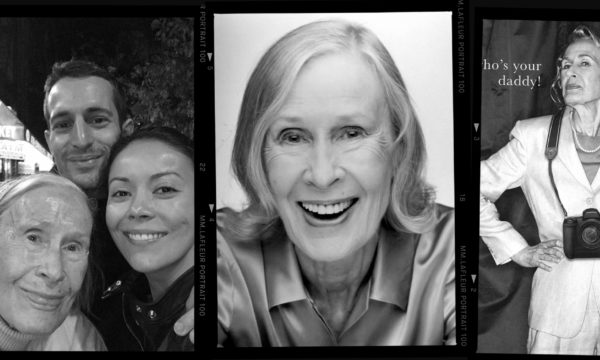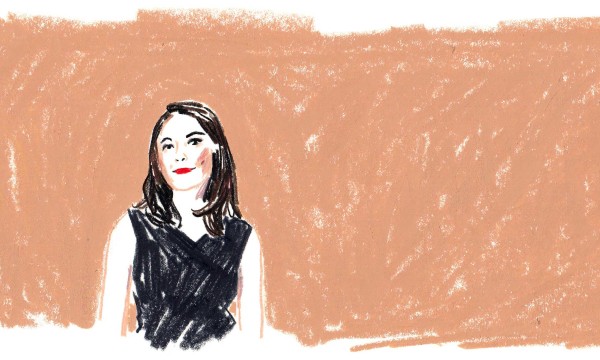
Shop similar styles: the Novara dress, Capri earrings, and Threads tights.
How Sarah LaFleur Dressed—and What She Learned—While Struggling with Infertility
M.M.LaFleur’s Founder & CEO spent years struggling with infertility before the birth of her three children last summer. Here’s what she wore while going through IVF, and the wisdom she picked up along the way.
In 2017, I turned 33, and my husband, Chris, and I, finally felt we were in a professional and financial position to think about adding kids to the mix. We thought it would be simple. We would “try” a few times and get pregnant, right?
Well, since it is Infertility Awareness Week, you should know that it didn’t happen quickly, easily, or without physical and emotional pain. In fact, it took three years, three egg retrievals, three embryo transfers, countless acupuncture sessions, and specialist visits to over twelve doctors. I calculated that I spent roughly 200 hours in a clinic just in 2018. While I knew I was lucky to be in a financial and geographical position to undergo these treatments, it was draining: financially, physically, emotionally. (Sidenote: if you live in New York, we’ve got good news for you: as of 2020, New York State now mandates that large insurance plans cover IVF.) I even got pregnant a couple of times, or so the pregnancy tests would say, only to get my period a few days or a week later. A really early miscarriage, if you will.
Factoring in the blood draws, the injections, weight gain, the hot flashes, the nausea, the heartburn, and the emotional rollercoaster, trying to figure out what to wear to work during this time was its own journey. There’s a good amount of content out there in terms of “maternity wear” or even “postpartum clothing,” but there aren’t guides on what to wear when undergoing egg retrievals, IVF, or even a miscarriage. But, in my own experience, I’ve found there are a few things you can integrate into your wardrobe that will be tremendously helpful, like stretchy, easy pieces that make you feel comfortable—or at least, as comfortable as you can be.
If you are struggling with infertility right now, know that I see you. Even after welcoming three babies—two via our incredible surrogate and one via, well, me—I consider infertility to have been one of my most life-defining experiences, and I will always be advocating for better care, financial coverage, and more understanding and support to all the fertility warriors out there.
Want more M Dash?
Sign up for our weekly newsletter.
Thank you!

Shop similar styles: the Annika tee and Claressa earrings.
How I Got Dressed and Lived Life While Doing IVF
For me, the number one challenge while navigating IVF was the continuous fluctuation in my body size and shape. While I didn’t have a scale at home, I think I probably put on (and sometimes lost) anywhere from ten to fifteen pounds during various hormone therapies. Form-fitting dresses went out the window. I personally like boxy, architectural styles, so I gravitated toward those looks, which made me feel stylish while also being loose and comfortable.
Stretchy materials were also a go-to for obvious reasons, and especially when I needed a little “snug and hug” therapy, I would pair our knits with our best-selling Foster pants, which are constructed in a way that eliminates the waist band, and therefore expands as your stomach does. (This is also true of my other favorite pair of pants, the Hockleys, though we didn’t have them available back in 2017).
Even now, 8 months post giving birth, my body is still very much in transition and not at all the way it was pre-pregnancy. While I didn’t know it at the time, it turns out that “IVF-wear” is not so different from “postpartum wear,” and the same pieces have ended up being my go-to pieces of clothing years later. (If I had to award one clothing item the “triple crown,” as in a product that I could have worn through every stage of IVF, during pregnancy, and post-pregnancy, it would be the Stella leggings. Whatever stage you find yourself in, these pants are magic, and you will always be relieved to have them in your closet.)

Shop similar styles: the Soyoung T-shirt, Milo jeans, Koio sneakers, and Circle buckle belt.
My Experience Leading Up to Egg Retrieval
What to expect: Each egg retrieval is typically a 10-15 day process, from start (as in the day they start monitoring you) to finish (as in when you go in for the actual egg retrieval process).
What it was like for me: I did three rounds of egg retrievals. For the first week or so, I would go into the clinic once every three to four days for an ultrasound (where they check your lining) and blood draws (where they check your level of hormones). Toward the last few days (think day 8 through 13), I went in every other day and sometimes every day. In short: be prepared to be at your clinic all.the.time!
What I wore: I tended to wear dresses with a jacket/cardigan or long-sleeve dresses because I found it easy to lift up my dress for ultrasounds rather than having to bother with pants or skirts (added plus: you can keep your bum warm rather than covering yourself with that sad piece of paper), and I could hide all the band-aids from the multiple blood draws I had to do. Some people would ask (with the best of intentions) if everything was ok when they saw that I had gotten my blood drawn. One person even asked me if I was pregnant! And sometimes you just can’t be bothered to explain. So arm coverage—even if just to wear during meetings, etc.—can be helpful.

The Anna jacket, Tippy dress, and Sant Ambroeus jardigan.
My unsolicited advice: If you are working from home during Covid, ironically, this might be one of the “best times” to do an egg retrieval, because you don’t need to commute into the office. If you are back at the office, consider talking to your supervisor about whether you are able to work remotely during this period. With the daily injections and frequent doctor’s visits, you may be more comfortable at home.
My Experience Leading Up to Egg Retrieval / IUI /Embryo transfers:
What to expect: Generally, you’re injecting yourself with something every morning and every evening. You might also be taking some oral medication and vitamins.
What it was like for me: For the most part, I got to inject myself from home in the early mornings and evenings, i.e. in my pajamas or sweatpants. For the first couple of days, I asked my husband to inject these shots into me (there’s something very counterintuitive about pushing a needle into yourself), and then eventually I got over it and realized it’s much less stressful to just do it myself (f you’ll let me brag for a moment, by the end, I could even inject things into my butt cheeks!) There were a few days, though, where I was on the road and had to do it in a hotel room, the office, or at a meeting site. One of my egg retrieval cycles coincided with an invitation to see Michelle Obama speak at Barclay’s Center in Brooklyn—the opportunity of a lifetime! The only thing was, I knew I had to give myself the “trigger shot” (arguably the most important shot in the entire egg retrieval process, where you have to inject yourself at a very specific time) right in the middle of her talk. So, for that one, I rudely left my seat mid-talk, ran into the women’s bathroom at the arena, and injected myself (I learned from Michelle’s book that she also went through IVF to have her daughters, Malia and Sasha, so I think she would forgive me for that one).

Shop similar styles: the Leo pullover and Yayoi earrings.

The Jie jacket and Foster pants.
What I wore: Make sure you wear something that gives you easy access to your mid-section. Button-down shirts are great. The Lagarde shirt was my go-to (and continued to be post-partum when I was nursing). The Harlem skirt, Rogala pant, and Stella leggings all have a similar fold-over construction that makes it easy to pull down and inject yourself, and also provide a bit of comfort around your midsection, like wearing a support band. (Note: the Harlem and Rogala are also great maternity wear pieces.)

The Harlem skirt, Shiloh pants, and Stella leggings.
On the day of your retrieval or transfer: relax! You are about to have the best 30 minute nap of your life. Go in your sweatpants and treat yourself to some salty foods afterwards (my choice was ramen).

My Experience Post Egg-Retrieval:
What to expect: Hurray! You did it! After your egg-retrieval, you’ll want to rest at home for at least two days. Your ovaries fill up with fluid, and you may experience bloating.
What it was like for me: I did three egg retrievals, and each time, I thought the hardest part about it was not leading up to it, but afterwards. My stomach was incredibly bloated for at least a week, and ironically, I looked four months pregnant. I also sometimes had a good amount of discomfort and pain. I remember keeling over in the subway once. It’s not a pleasant time.

What I wore: Forget skinny jeans, pencil skirts, or anything with a waist. Forgiving dresses were godsends. The Gigi dress was what kept me company, and as you can tell from the photo above (shot during a trip to India with Miyako!) I even had it custom-made in different fabrics. While the Lou dress wasn’t available at the time, it would have been my first pick. If you’re in a more professional environment, the Maaza and Sarah dresses will give you the coverage you need.

The Gigi dress, Maaza dress, and Lou dress.
Shop This Look
My unsolicited advice: We had an important breakfast scheduled for the day after my egg retrieval, which had been scheduled for weeks at that point, so I went. Big mistake. I felt horrible. Things are so unpredictable, because you just don’t know when your egg retrieval is going to be scheduled or how you will feel afterwards. Tell your supervisor or your teammates if you can, and try not to schedule anything important for a week after your approximate egg retrieval date.

My Experience with Hot Flashes and Lupron Depot Treatments for Endometriosis)
What to expect: For those of you who are struggling with or could be suffering with endometriosis, your doctor might prescribe you Lupron depot treatments, where a healthcare professional will inject you with lupron to help relieve the pain of endometriosis and reduce endometriotic lesions. Depot lupron reduces the levels of estrogen in your body, so the experience is very similar to going through menopause.

Shop similar styles: the Mila button-down and Foster pants.

Shop similar styles: the Liam sweater and Foster pants.
What it was like for me: I got two shots, one per month over two months. Of course, I decided to get this treatment in July and August, and let me tell you, it was one hot summer. I had such intense hot flashes, all I could think about was stripping naked and sticking my head in the freezer. My second best option was wearing linen and cotton.
What I wore: Linen pieces have a way of sometimes looking “sloppy” because they wrinkle easily, but that’s where our stretch linen pieces, which are blended with elastane, really shine. I own six pairs of Chester pants (three colors, two sizes for each) and basically lived in them throughout the summer.

The Annika top, Samara sweater, and Chester pant.
We all draw comfort from different sources—a bowl of pasta, the scent of lavender, a bath. For me, clothing has been and always will be one of the most powerful tools that lift my mood and help me feel the way I want to feel. Throughout this journey, which was often lonely and consistently unpredictable, what I was always seeking was comfort, and these were the pieces that provided that for me.
One of the things that I think we do well at M.M. is really understanding where you are in your life and helping you build your wardrobe around that. Our stylists have worked with women in all different types of circumstances: new jobs, promotions, interviews, pregnancy, chemotherapy, mastectomies, menopause, weight gain, weight loss, and even heartbreak. You name it, we’ve built a wardrobe around it. Infertility is one of the challenges many women will encounter, and while clothing can never change the outcome, if we can play a small part in making that journey easier for you, nothing would make me happier.







